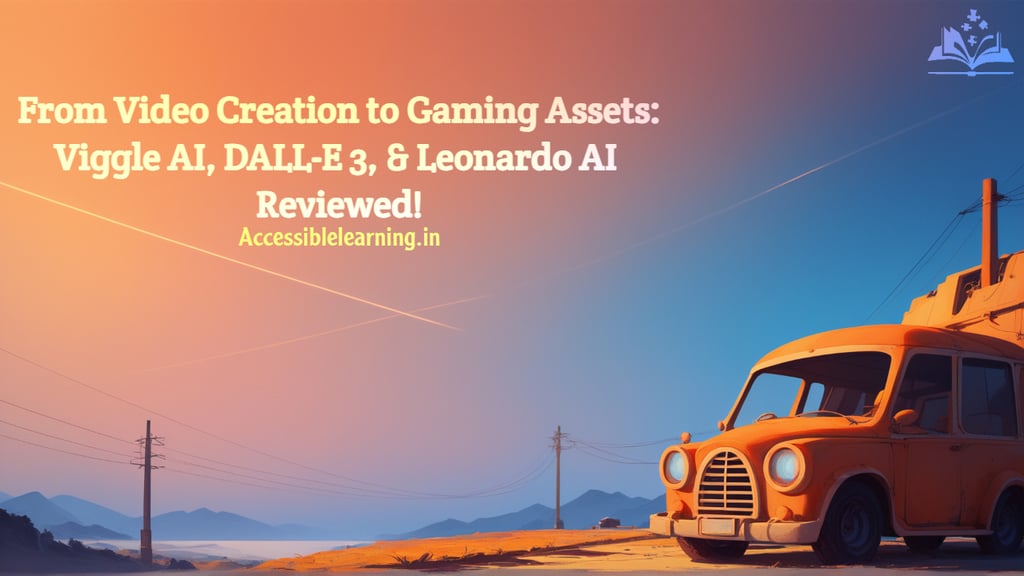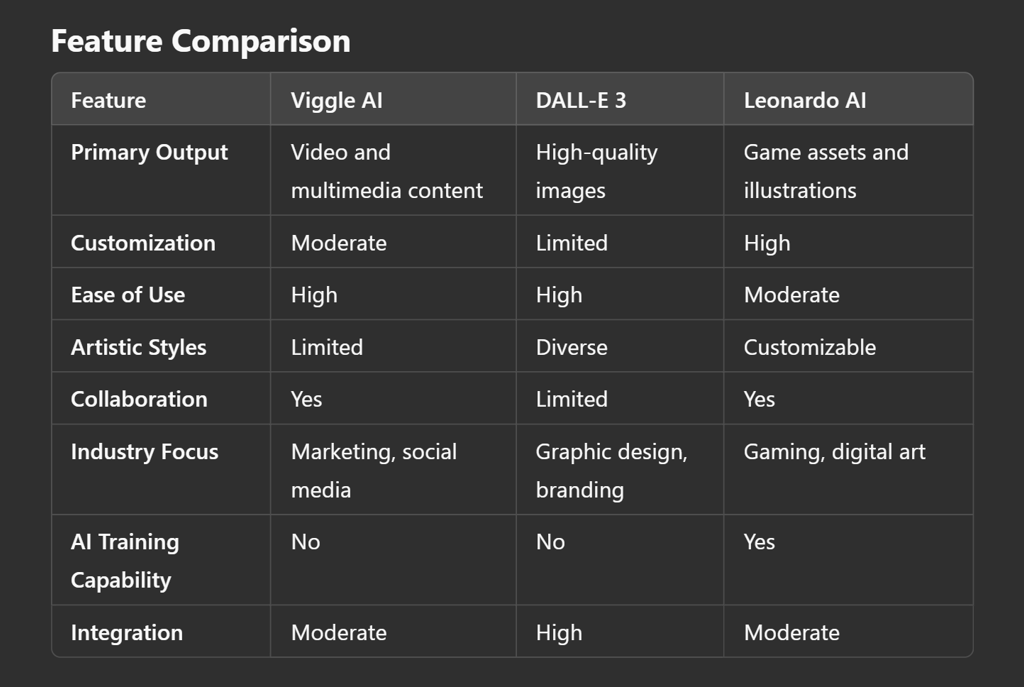
Viggle AI vs DALL-E 3 vs Leonardo AI: Which Creative AI is Right for You?
Discover an in-depth comparison of Viggle AI, DALL-E 3, and Leonardo AI—three leading creative AI tools. Explore their features, strengths, use cases, and industries they cater to, helping you choose the perfect solution for your creative needs.
AI ART TOOLSARTIST/CREATIVITYEDITOR/TOOLSAI/FUTUREEDUCATION/KNOWLEDGE
Sachin K Chaurasiya
12/24/20246 min read


In the ever-evolving world of artificial intelligence, creative tools have emerged as game-changers in industries ranging from entertainment to marketing and beyond. Among these tools, Viggle AI, DALL-E 3, and Leonardo AI stand out for their ability to generate stunning visuals and content through advanced algorithms. This article delves deep into their capabilities, use cases, and features to provide a clear comparison for users seeking the best AI tool for their needs.
Viggle AI
Viggle AI is a relatively new entrant in the creative AI space, focusing primarily on video and multimedia content generation. Its standout features include
Dynamic Video Editing: Viggle AI excels in automating video creation, offering templates and AI-driven transitions that cater to marketers, content creators, and social media influencers.
AI-Powered Storyboarding: This feature allows users to map out video concepts visually, making it easier to plan and execute projects with precision.
Text-to-Video Conversion: By analyzing text inputs, Viggle AI generates compelling video content, complete with visuals, animations, and voiceovers.
Custom Branding Elements: Users can incorporate their brand's logos, colors, and style into video outputs for a consistent look.
Collaborative Features: Teams can work together on video projects, ensuring seamless collaboration and quicker project delivery.
Focus Areas: Video marketing, advertisement campaigns, and multimedia storytelling.
Use Cases
Marketing Campaigns: Automatically generate promotional videos tailored to specific audiences.
Content Creation: Streamline video production for social media platforms like Instagram and YouTube.
Educational Tutorials: Produce engaging and visually appealing tutorial videos.
Corporate Training Videos: Develop polished training materials quickly and efficiently.
Strengths & Limitations
Strengths: Excellent for video creation, user-friendly interface, and rapid output generation.
Limitations: Lacks advanced customization and is not ideal for static image creation.
Integration Capabilities
While primarily focused on video production, it offers basic integration with social media platforms and content management systems, making it easier for creators to publish and share their work directly.
Pricing & Accessibility
Generally subscription-based with tiered plans targeting content creators and small-to-medium businesses. A free trial might be available for exploration.
Target Audience
Geared toward marketers, educators, and social media influencers who need quick, high-quality video production without extensive technical skills.
AI Ethics & Usage Guidelines
Since it’s more focused on videos, ethical challenges are generally related to potential misuse of branded content or misleading advertisements.
Performance in Emerging Trends
Its ability to generate engaging video ads aligns with the growing popularity of short-form video content on platforms like TikTok and Instagram Reels.
User Communities and Ecosystem
Viggle AI has an emerging but growing community of marketers and influencers sharing templates and best practices.
Potential Innovations
Viggle AI Likely to integrate AI-driven analytics to measure video performance, enabling data-informed content strategies.


DALL-E 3
Developed by OpenAI, DALL-E 3 is the third iteration of the widely popular DALL-E series. It specializes in generating high-quality images from textual descriptions, showcasing unmatched precision and creativity. Key highlights include:
Text-to-Image Precision: DALL-E 3 translates user prompts into detailed and coherent images, making it ideal for graphic designers and concept artists.
Enhanced Context Understanding: Unlike its predecessors, DALL-E 3 provides better contextual understanding, ensuring images align perfectly with user intentions.
Artistic Styles: From photorealistic renderings to abstract art, DALL-E 3 supports a wide variety of styles.
Integration with Design Tools: DALL-E 3 can integrate with popular design platforms, streamlining the creative workflow.
Ethical AI Controls: Built-in safeguards ensure the generation of safe and appropriate content.
Focus Areas: Concept art, marketing visuals, and customized imagery for branding.
Use Cases
Branding and Advertising: Create unique and striking visuals for product campaigns.
Concept Visualization: Aid in the design of prototypes or storyboards with realistic images.
Artistic Projects: Provide artists with inspiration or supplement their creative process.
E-Commerce Listings: Generate eye-catching product images to enhance online sales.
Strengths & Limitations
Strengths: Exceptional image quality, diverse styles, and superior contextual understanding.
Limitations: Limited customization options compared to Leonardo AI, focused solely on images.
Integration Capabilities
OpenAI has worked on integration with popular platforms like Microsoft Designer and Canva, offering designers a seamless experience. This makes it particularly appealing for professionals already using these tools.
Pricing and Accessibility
Access is often tied to OpenAI's API credits, with varying pricing depending on the level of usage. Free-tier options are sometimes offered for limited prompt generations.
Target Audience
Appeals to graphic designers, branding agencies, and casual users seeking unique images for presentations, campaigns, or personal projects.
AI Ethics & Usage Guidelines
OpenAI enforces strict usage policies to prevent the creation of harmful, misleading, or offensive content. Filters are built-in to ensure ethical outputs.
Performance in Emerging Trends
DALL-E 3 is central to the movement of AI-generated art exhibitions and commercial projects, showcasing its ability to democratize creativity.
User Communities & Ecosystem
Backed by OpenAI’s robust ecosystem, it benefits from a massive community of enthusiasts, professional designers, and developers who regularly explore its capabilities.
Potential Innovations
DALL-E 3 could introduce advanced stylization features, allowing users to blend styles or mimic specific artistic movements more precisely.


Leonardo AI
Leonardo AI has carved a niche in the AI-generated art domain by emphasizing customization and control. Known for its versatility and user-friendly interface, Leonardo AI offers:
Style Training: Users can train the AI on specific styles, ensuring outputs match brand or personal aesthetics.
Asset Creation: Ideal for game developers and digital artists, Leonardo AI generates assets like characters, environments, and icons.
Iterative Refinements: Users can tweak and refine outputs for greater accuracy and alignment with their vision.
Batch Generation: Leonardo AI allows users to generate multiple assets simultaneously, saving time in large-scale projects.
Community and Pre-Trained Models: Access to a library of pre-trained models and styles, offering inspiration and quick solutions.
Focus Areas: Gaming, digital art, and specialized asset creation.
Use Cases
Game Development: Generate custom assets for characters, landscapes, and props.
Comic and Illustration: Assist illustrators in creating detailed and stylized visuals.
Product Design: Aid designers in conceptualizing new products or packaging designs.
Interactive Media: Provide assets for virtual reality (VR) and augmented reality (AR) applications.
Strengths & Limitations
Strengths: High degree of control, supports iterative refinements, and caters to niche markets like gaming.
Limitations: Steeper learning curve and less focus on video or multimedia content.
Integration Capabilities
Although it doesn't offer extensive integrations with mainstream platforms, Leonardo AI allows API access, enabling developers to embed its capabilities into custom workflows.
Pricing & Accessibility
More targeted toward professionals, its pricing model caters to larger-scale operations like game development teams and studios. However, its extensive feature set justifies the cost for specialized users.
Target Audience
Designed for niche creators such as game developers, illustrators, and product designers who require detailed customization and iterative refinement.
AI Ethics & Usage Guidelines
While it allows greater customization, it also provides guidelines to prevent misuse. However, its openness to iterative refinement could make it a double-edged sword for misuse.
Performance in Emerging Trends
Leonardo AI in Gaming Trends With the rise of metaverse projects and immersive game environments, Leonardo AI’s capacity for asset generation gives it a distinct advantage.
User Communities & Ecosystem
A smaller, tightly knit community, often comprising professional creators and developers focused on asset creation for specific industries.
Potential Innovations
May expand into real-time asset generation for AR and VR applications, further solidifying its role in futuristic gaming and media projects.


Which One Should You Choose?
For Video Creators: Viggle AI is the clear winner, offering specialized tools for video production and marketing.
For Artists and Designers: DALL-E 3 provides unmatched image generation capabilities with diverse artistic styles.
For Game Developers: Leonardo AI stands out for its ability to create customized assets and illustrations tailored to gaming needs.
Future Prospects
The creative AI industry is rapidly evolving, and these tools are likely to see continuous improvements. Viggle AI might expand into more multimedia formats, DALL-E 3 could add deeper customization features, and Leonardo AI may integrate more seamless workflows for the gaming and digital art industries. Keeping an eye on updates and advancements is crucial to leveraging these tools effectively.
Choosing between Viggle AI, DALL-E 3, and Leonardo AI depends largely on your specific needs and industry focus. Viggle AI dominates the video production arena, DALL-E 3 excels in image generation, and Leonardo AI caters to niche markets requiring customized assets. By understanding their unique capabilities, you can make informed decisions that enhance your creative endeavors.
Subscribe To Our Newsletter
All © Copyright reserved by Accessible-Learning Hub
| Terms & Conditions
Knowledge is power. Learn with Us. 📚


